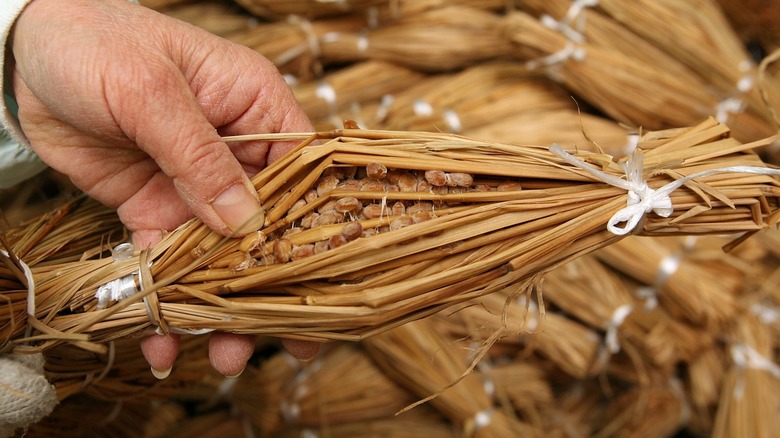The Accidental Origins Of Natto
A traditional Japanese breakfast is a harmonious array of colorful, nutritious dishes. Often, at its heart is natto, fermented soybeans enveloped in a stringy coating that can be enjoyed in many ways, including on its own, over rice, or stirred into miso soup. Celebrated as a superfood rich in probiotics worth incorporating into your daily diet, natto has been proven to aid gut, heart, bone, and immune health. It also has cultural roots in Japan, stretching back thousands of years.
Equally fascinating as its health benefits are the origin stories behind it. Like many fermented foods, including cheese, natto's invention is often attributed to accidental discoveries, with numerous stories crediting its creation to chance. One such story connects natto to 7th-century Japan, during the spread of Buddhism.
It is said that in the Asuka Period, Prince Shotoku wrapped leftover boiled soybeans, intended as feed for his horse, in straw and hung them in a tree, inadvertently uncovering the method for fermenting natto. Finding the fermented beans were delicious, the prince, a dedicated Buddhist scholar, helped incorporate natto into shojin-ryori, the plant-based diet of Zen monks. Natto, made by fermenting steamed soybeans, either whole or crushed, with bacteria for up to 24 hours, followed by refrigeration, is sometimes still prepared in rice straw, though this practice is less common.
Other legendary tales of natto's accidental discovery
While other theories suggest that natto was introduced to Japan from China, possibly from Yunnan province, a region famous for fermented soybeans, or brought over during the Tang dynasty in the Nara Period (710 to 794 A.D.), some of the most treasured and entertaining stories about its origins are linked to serendipitous events also rooted in Japan — much like the Prince Shotoku legend mentioned earlier.
One of the most well-known tales is tied to a moment of wartime haste. In 1051 A.D., Minamoto no Yoshiie, a legendary warrior, ordered his troops to pack freshly boiled soybeans into rice straw bales as warhorse feed before setting out to suppress a rebellion. During the journey, the horses' body temperature combined with moisture and the bacteria on the straw, causing the beans to ferment. Noticing a pungent smell from the bales, Yoshiie discovered the beans were covered in a stringy white layer that tasted surprisingly good, and just like that, natto was born.
Yet another legend dates back to the Yayoi Period (300 B.C. to 300 A.D.), when rice farming and soybeans were introduced to Japan from China. It is believed that natto originated by chance when soybeans accidentally fell onto straw mats used as flooring and naturally fermented there.

